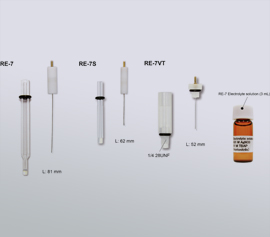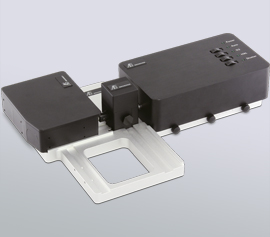GAMRY ACCESSORIES FOR ELECTROCHEMISTRY

The MK 3 simulates with high accuracy typical fuel cell conditions for conductivity measurements via electrochemical impedance spectroscopy in combination with the Gamry System Reference 600+ or Interface 1010E.
The fumatech MK 3 conductivity cell is designed for measuring the proton conductivity and the general ionic conductivity of membrane samples in a temperature range from room temperature up to 200°C with an additional potentiostat. The measurements can be performed under selected humidification as well as in dry condition. Suitable potentiostats for operation with the MK 3 are e.g. the Gamry Reference 600+ Potentiostat/Galvanostat/ZRA or the Gamry Interface 1010E Potentiostat/GalvanostatZRA).

The design of the Lithium Battery Materials Cell Kit allows very flexible investigation of electrode materials of a lithium-based galvanic cell.
The Lithium Battery Materials Cell Kit is available in the versions "standard", "half-cell" and "whole cell" and enables very flexible mounting and dismounting of up to three electrodes made of foil, wire or bulk material in a lithium-based galvanic cell within a glove box.

RDE710 Rotator for RDE, RRDE and RCE is designed for hydrodynamically controlled electrode reactions both for the characterization of catalysts and for determining flow-induced corrosion rates.
The RDE710 - Rotating Disk (RDE), Ring Disk (RRDE) or Cylinder Electrode (RCE) from Gamry is a fast DC permanent magnet motor with low inertia. Between 50 rpm and 10.000 rpm, a wide variety of materials in coordination with the shaft and electrodes can be controlled manually or digitally in conjunction with a potentiostat.

The successor to the Gamry VISTASHIELD continues to provide effective shielding from environmental electronic noise for demanding measurements at very low current levels and even with large measuring cells.
Like its predecessor, the collapsible Faraday cage offers efficient shielding from electrical interference signals from the laboratory environment (rotary pumps, fluorescent tubes, etc.). The spacious interior allows the accommodation of a wide variety of even larger electrochemical measuring cells such as Gamry's Dr. Bob's cell, voltammetry measuring cells or Gamry's multipurpose corrosion measuring cell. The cage can also accommodate an IMPS/IMVS setup for characterization of dye-sensitized solar cells or cells for spectroelectrochemistry from UV/VIS to NIR or Raman.

Dr. Bob´s Cell Kit is made entirely of inert materials and is used in a variety of applications to characterize unknown electroactive species.
Dr. Bob's Cell Kit can be used for various applications such as studies on enzymes and catalysts, electrochemical sensors, galvanic cells, redox potentials of inorganic complexes, etc. with micro and macro working electrodes made of platinum, gold or glassy carbon. Alternative electrode materials must be made available in holders of 110 mm length and diameters between 6.5 mm and 7.5 mm.

The Euro Cell Kit is the entry-level model for electrochemical corrosion measurements on cylindrical specimens
The Euro Cell Kit is designed for electrochemical corrosion measurements in 125 ml - 175 ml electrolyte volume. The components of the Euro Cell Kit have been selected for maximum chemical resistance, but nevertheless do not allow the use in hydrofluoric acid (HF) or in alkaline electrolytes.

With Gamry´s FlexCell Cell Kit the critical pitting temperature is determined while avoiding the effects of crevice corrosion on flat specimens.
With Gamry´s FlexCell the critical pitting temperature on flat specimens can be determined with the flooded contact seal of "Avesta Steel" while avoiding crevice corrosion.

The design of the MultiPort Corrosion Cell Kit allows easy cleaning and a high degree of flexibility for electrochemical corrosion experiments on many sample geometries.
The MultiPort Corrosion Cell Kit is designed for ease of use, reliability and easy cleaning. In addition to electrochemical corrosion experiments at a constant temperature, the optional heating and cooling jacket also allows temperature-dependent investigations for better elucidation of the heterogeneous redox reaction system in an electrolyte volume of 1000 ml.

The ParaCell Kit for galvanic corrosion measurements and electrochemical noise measurements enables the investigation of many flat samples either against a graphite counter electrode or a second working electrode in symmetrical arrangement.
With the ParaCell Kit for Flat Specimen the working and counter electrodes are brought into contact with each other via the electrolyte capacity of 300 ml and identical electrode surface areas. Cell and electrode geometry meets the requirements for measurements of electrochemical noise as well as galvanic corrosion currents using a Zero Resistance Ammeter.

The Paint Test Cell Kit is the smallest and most cost-effective electrochemical measuring cell kit from Gamry.
For the investigation of corrosion processes on coated specimens or bare metal surfaces in masked surface areas, the Paint Test Cell Kit (PTC1) is so cost-effective that many users appreciate Gamry's smallest electrochemical cell with an electrolyte volume of approx. 40 ml also for the parallel investigation of several specimens side by side.

This experimental setup of a synchronized bipotentiostat and an optical bench is used for the detailed characterization of dye solar cells
For the characterization of Dye Sensitized Solar Cells (DSSC's) with the Dye Solar Cell Testing Kit (IMPS/IMVS) light from LEDs of discrete wavelengths (470 nm, 530 nm, 590 nm, 617 nm, 625 nm and 940 nm) is focused on the active area of the dye solar cell and the response to the irradiated light is measured. For electrochemical characterization, a bipotentiostatic setup is used in which one potentiostat drives the LED and a second potentiostat tracks the response by recording data...

The selection of the correct reference electrode determines the quality for electrochemical measurement results and their lifetime.
High quality electrochemical measurements require a stable reference electrode potential and a low impedance reference electrode junction or frit. In contrast, inaccuracies in potential measurement due to an unstable reference electrode can cause erraneous results whereas a high impedance reference electrode frit in the range of several kΩ causes potentiostat oscillation.

Working electrodes of different dimensions and inert materials
Screen printed-, macro and micro working electrodes for analytical electrochemistry and basic physical electrochemistry
ALS ACCESSORIES FOR ELECTROCHEMISTRY

Electrochemical Cell for simultaneous investigations of optical properties and electrochemical redox reactions
Spectro-electrochemical Cells are used for simultaneous measurements of optical and electrochemical properties of a sample. We offer cuvettes for static applications and flow cells for continuous processes or changing electrolytes. A variety of different working and reference electrodes allows a flexible adaption to different measurement tasks.

RRDE-3A Rotator for measurements on rotating disk or ring-disk electrodes
With the RRDE-3A Rotator system measurements on rotating Disk- or Ring-Disk-Electrodes can be performed. The variation of the rotation rate allows to control the hydrodynamic properties and therefore to control the diffusion during voltametric measurements. A variety of materials as working electrodes are available, electrodes with exchangeable disks allow pre-processing of disks or the use of custom materials.

Portable hydrogen generator H2G1 and the Reversible Hydrogen Electrode (RHE) to generate Hydrogen and using the Reversible Hydrogen Electrode as a reference electrode.
The potential of electrochemical reactions is normalized versus the potential of a normal hydrogen electrode. The portable hydrogen generator H2G1 and the Reversible Hydrogen Electrode (RHE) offer an easy to use system to generate Hydrogen in the Reversible Hydrogen Electrode and to use it as a standard reference electrode.

Reference electrodes are used for the majority of electrochemical methods
Reference electrodes are needed for almost all kinds of electrochemical methods. ALS offers a variety of different electrodes for aqueous electrolytes and electrodes for organic media as well as a Reversible Hydrogen Electrode (RHE).

Non-aqueous reference electrodes are used for electrochemical methods in aprotic, organic solvents.
Reference electrodes are needed for almost all kinds of electrochemical methods. ALS offers a variety of different electrodes for aqueous electrolytes and electrodes for organic media as well as a Reversible Hydrogen Electrode (RHE).

Working electrodes for different electrochemical applications like CV, LSV, and DPV
ALS offers a broad variety of working electrodes with different electrode materials and different dimensions. Micro electrodes for small sample volumes and fast measurements as well as mesh type electrodes with high surface area are available.

Lithographic electrodes for static ring-disk measurements, conductivity electrodes and Interdigitated Array (IDA) electrodes for experiments with small sample volumes
Due to the small dimensions, lithographically manufactured electrodes offer the possibility to measure small sample volumes with low detection limits. These electrodes are available for ring-disk experiments, conductivity measurements, and electrochemical experiments and sensors.

Counter or Auxiliary electrodes for a variety of applications like CV, LSV, or DPV
ALS offers a variety of counter electrodes made from different materials and in different sizes and shapes.

Voltammetry cells with different volumes and a variety of operation modes
The cells offer a variety of applications like CV, LSV, and DPV. Different sizes and volumes allow using small amounts of sample and safe expensive electrolytes. Electrolysis or electrochemical synthesis can be performed in the Bulk Electrolysis Cell. Flat samples dan be measured using the Plate Material Evaluating Cell.

Durchflusszellen für die Detektion niedrigster Konzentration in Kombinationen mit HPLC, FIA (Flow Injection Analysis) sowie den Einsatz in der Biosensorik.
ALS offers different flow cells; cross flow cells creating a linear, laminar flow and radial flow cells with a central injection of the sample and a radiale outlet channel. The cells are used for detection in measurement systems like HPLC, FIA and microcapillary/microbore liquid chromatography.

Glassy Carbon products in a variety of different sizes and shapes, like films, plates, powders, and rods used as working or counter electrodes
Glassy Carbon consists of pure carbon with a very unique structure. Due to its outstanding properties it is often used for working or counter electrodes in different applications.

Useful accessories for working and reference electrodes
ALS offers a variety of useful accessories to build, maintain and take care of working and reference electrodes. Using Carbon paste or Silver/silver chloride ink working or reference electrodes can be set up, the polishing kit working electrode surfaces can be cleaned and polished; and the preservative vial prevents reference electrodes from drying out and cracking of the frit.


























